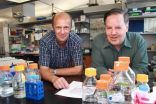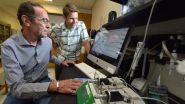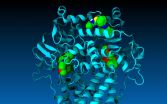(Press-News.org) Scientists at Texas A&M University have made additional progress in understanding the process behind scar-tissue formation and wound healing -- specifically, a breakthrough in fibroblast-to-fibrocyte signaling involving two key proteins that work together to promote fibrocyte differentiation to lethal excess -- that could lead to new advances in treating and preventing fibrotic disease.
A new study led by biologists Richard Gomer and Darrell Pilling and involving Texas A&M graduate students Nehemiah Cox and Rice University technician Varsha Vakil points to a naturally occurring blood protein, lumican, that, when stimulated by a fibrocyte-secreted protein called tumor necrosis factor alpha (TNF-alpha), triggers a vicious cycle causing inappropriate and uncontrolled formation of scar tissue in fibrotic diseases. Their work, funded by the National Institutes of Health, is published in the current issue of the Proceedings of the National Academy of Sciences.
Fibrotic diseases occur when the body's natural healing mechanisms malfunction and create excessive scar tissue in vital organs, to the point that it becomes harmful. These diseases are wide-ranging -- lung, kidney, liver and heart fibrosis are some of the most common -- and are associated with 45 percent of U.S. deaths per year.
For their analysis, Gomer and Pilling examined the lung tissue of human patients with pulmonary fibrosis and observed the presence of lumican. In patients with relatively normal lung function, the lumican was present at lower levels, whereas it was more prevalent in patients in advanced stages of the disease.
"Our data suggests that lumican may be one of the unknown signals from fibroblasts to fibrocytes that controls part of a runaway feedback loop that encourages fibrosis," Gomer said. "Therefore, lumican-inhibiting drugs may prove useful as possible therapeutic treatments for fibrosis."
Gomer and Pilling, who joined the Texas A&M Department of Biology in 2010, were able to show in previous studies that bacteria-fighting white blood cells called monocytes enter fibrotic lesions and develop into wound-healing fibrocytes, which are cells that help to mediate tissue repair. Researchers have theorized that the development of fibrosis may involve a miscommunication between fibrocytes and fibroblasts, the main cells that form scar tissue.
In their most recent work, Gomer and Pilling zeroed in on TNF-alpha as a possible source of the miscommunication. While fibroblasts naturally only produce a small amount of lumican, TNF-alpha stimulates them to produce even more lumican during scar formation. The excessive lumican triggers monocytes, which can differentiate to play multiple roles in immune-system function, to become fibrocytes -- a transformation that results in additional TNF-alpha production that, in turn, triggers increased lumican production. Ultimately, this leads to an overabundance of scar tissue in the lungs, a process called a positive feedback loop.
"This research may help explain why fibrosis persists, why it is difficult to treat, and may suggest new methods to treat fibrosis," Pilling said.
Fibrotic diseases and potential treatments have become a hot talking point in biomedical circles in recent years, and both Gomer and Pilling have become nationally recognized as preeminent authorities on fibrotic research.
In the early 2000s, the two identified another naturally occurring blood protein called serum amyloid P, or SAP, as a signal that inhibits the formation of fibrocytes. By 2006, their work to harness SAP's wound healing capabilities had progressed to the point that they co-founded a company, Promedior Inc., to further develop SAP-related technology.
Their first major breakthrough came in 2007, when they and colleagues found that SAP is effective at preventing fibrotic disease in the lungs and hearts of laboratory animals. In 2013 and 2014, Promedior announced that early clinical trials of a treatment involving a recombinant form of SAP, PRM-151, indicated a successful reduction of symptoms in patients with lung fibrosis and myelofibrosis, a life-threatening scarring of bone marrow.
On Aug. 31, New York-based global biopharmaceutical company Bristol-Myers Squibb announced an agreement to give Promedior $150 million to fund further clinical trials and potentially to acquire Promedior for up to $1.25 billion.
"We are obviously delighted that Bristol-Myers Squibb is supporting the work to break the vicious cycle in fibrosis and thus help patients with fibrosing diseases," Gomer said.
From identifying SAP as the protein that inhibits scar-tissue formation to investigating its direct competition, lumican, as the protein that promotes it, Gomer says the real winner in his and Pilling's ongoing research is the patient.
"It looks like SAP rules them all," Gomer said. "The proof of the pudding is that SAP treatments cause patients to improve, not just stabilize. So to our delight, it looks like SAP is a dominant factor."
INFORMATION:
To learn more about Gomer and Pilling and their research, visit http://www.bio.tamu.edu/USERS/gomer/index.html.
For additional information about Promedior Inc., go to http://www.promedior.com/index.html.
Contrary to popular belief, the worst injuries baseball catchers face on the field come from errant bats and foul balls, not home-plate collisions with base runners, according to findings of a study led by researchers at the Johns Hopkins University School of Medicine.
The research, done in collaboration with Baltimore Orioles trainers Brian Ebel and Richard Bancells, involved analysis of all catcher injuries during major league baseball games over a 10-year period.
A summary of the findings, published ahead of print Aug. 28 in the American Journal of Sports Medicine, ...
AUGUSTA, Ga. - The regular physical trauma that appears to put professional football players at risk for degenerative brain disease may also increase their risk for hypertension and cardiovascular disease, researchers say.
The frequent hits football players experience, particularly frontline defenders such as linemen, likely continually activate the body's natural defense system, producing chronic inflammation that is known to drive blood pressure up, according to a study in The FASEB Journal.
While strenuous physical activity clearly has its benefits, it also produces ...
Researchers at Southern Methodist University, Dallas, have discovered three new drug-like compounds that could ultimately offer better odds of survival to prostate cancer patients.
The drug-like compounds can be modified and developed into medicines that target a protein in the human body that is responsible for chemotherapy resistance in cancers, said biochemist Pia D. Vogel, lead author on the scientific paper reporting the discovery.
So far there's no approved drug on the market that reverses cancer chemotherapy resistance caused by P-glycoprotein, or P-gp for short, ...
Using "mini-brains" built with induced pluripotent stem cells derived from patients with a rare, but devastating, neurological disorder, researchers at University of California, San Diego School of Medicine say they have identified a drug candidate that appears to "rescue" dysfunctional cells by suppressing a critical genetic alteration.
Their findings are published in the September 8 online issue of Molecular Psychiatry.
The neurological disorder is called MECP2 duplication syndrome. First described in 2005, it is caused by duplication of genetic material in a specific ...
ALEXANDRIA, VA--The latest research on hearing loss, head and neck cancers, sleep apnea and other otolaryngic topics will be presented in Dallas, TX, September 27-30, at the 2015 Annual Meeting & OTO EXPO? of the American Academy of Otolaryngology--Head and Neck Surgery Foundation (AAO-HNSF), the largest annual meeting of ear, nose, throat, head and neck physicians in the world.
Abstracts of the research to be presented are now available online at http://oto.sagepub.com/content/153/1_suppl.toc. The 2015 Annual Meeting features more than 380 oral and 180 poster presentations ...
ATLANTA - September 8, 2015-New American Cancer Society Cancer Survivorship Care guidelines released today provide primary care clinicians with recommendations for providing comprehensive care to the estimated 1.2 million survivors of colorectal cancer in the United States.
The guidelines are the second to be published in a series of cancer survivorship care guidelines developed by the American Cancer Society. They provide guidance on identifying and managing potential physical and psychosocial long-term and late effects of colorectal cancer and its treatment, as well ...
PITTSBURGH, Sept. 8, 2015 - Young people across the United States who smoke electronic cigarettes are considerably more likely to start smoking traditional cigarettes within a year than their peers who do not smoke e-cigarettes, according to an analysis led by the University of Pittsburgh Center for Research on Media, Technology, and Health (CRMTH) and the Dartmouth-Hitchcock Norris Cotton Cancer Center. The study, funded by the National Cancer Institute (NCI), was the first to assess this relation in a national U.S. sample of youth, and to include people older than 18 ...
Continued smoking after a diagnosis of multiple sclerosis (MS) appears to be associated with accelerated disease progression compared with those patients who quit smoking, according to an article published online by JAMA Neurology.
MS is a neurogenerative disease and smoking is one of its known risk factors. While MS begins with an initial course of irregular and worsening relapses, it usually changes after about 20 years into secondary progressive (SP) disease. The time from onset to conversion to SPMS is a frequently used measure of disease progression.
Jan Hillert, ...
About one-third of girls and boys who survived child trafficking experienced physical and/or sexual violence during their ordeal in a study of children receiving posttrafficking services in Cambodia, Thailand and Vietnam, according to an article published online by JAMA Pediatrics.
Many of these survivors of child trafficking in the Greater Mekong Subregion of Southeast Asia screened positive for depression, anxiety and posttraumatic stress disorder (PTSD), and mental health symptoms were associated with self-harm and suicide ideation, according to the article.
Millions ...
A new study of U.S. adolescents and young people suggests that using electronic cigarettes was associated with progression to traditional cigarette smoking, according to an article published online by JAMA Pediatrics.
Some studies suggest e-cigarettes may help smokers reduce the use of traditional tobacco products. Still, there is concern that e-cigarette marketing could position the product to recruit nonsmokers and the use of e-cigarettes has increased among both adolescents and young adults.
Brian A. Primack, M.D., Ph.D., of the University of Pittsburgh School of ...




